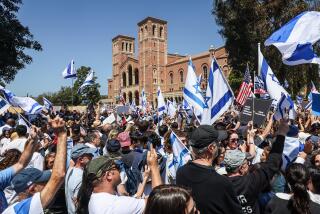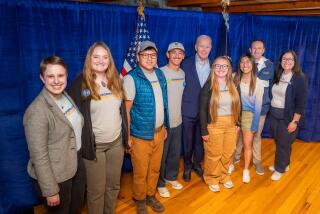Together Again : These Cadets Kept Heads in Clouds
- Share via
Forty-three years ago, America was at war, normal living was suspended and 200 young soldiers spent a year studying a subject few of them would ever use. Then they scattered all over the world.
Hardly an experience that seemed as if it would influence them for a lifetime--but that’s what it did, they agreed when they saw each other last weekend for the first time since 1944, when they left Pomona College.
“We were the best, we knew it and we were damn proud of it,” said Bliss Bushman of Claremont, organizer of one of the college’s most unusual reunions.
In 1943, Pomona was one of 14 colleges and universities throughout the country to contract with the Army Air Corps to provide an intensive one-year training program in meteorology.
Intensive Study
An Air Corps announcement said that “young men of high promise,” aged 18 to 21, who tested high in math and science would be accepted. The Pre-Meteorological Detachment at Pomona College prepared to become military weathermen in World War II through intensive study in math, vector mechanics, physics, geography, history and composition.
The competition among them was intense, the “washout” rate was high, and two years of college work were covered in that one year. Every minute was programmed from 6 a.m. to 9 p.m., recalled the men, who nevertheless found enough time to court and marry a number of Pomona College co-eds during and after the war.
“If you got 75% on just one exam, you were sent to gunnery school,” Bushman recalled. “I got a 76% once, and did I hit the books!”
The Pomona detachment’s yearbook contains tributes to the group from top military brass for having the highest scholastic and athletic achievement among similar Army programs.
Group Disbanded
Ironically, the Air Corps trained hundreds more meteorologists than it needed, so the Pre-Meteorological Detachment at Pomona College was disbanded after completing the required year of study, and its cadets were sent to other training programs or to active duty. Only a handful ever served as meteorologists during the war, and only one made meteorology his career in civilian life. He was not at the reunion.
“We always had the feeling we were lost in some general’s crap game,” said William Graham of Silver Lakes, retired president of Barstow College.
“We’d been built up to be elite officers, and it was a complete waste of manpower,” Graham said. “But the program may have contributed more in the long run. I think it made us all overachievers. I think I got my Ph.D. because of this.”
Graham also is a former president of colleges in Missouri and Florida and has a long list of academic positions, including director of the Tournament of Roses Band at Pasadena City College in the early 1950s.
Strong Ties
Like many of his former classmates, Graham has been married to the same woman for more than 40 years and has well-educated children and several grandchildren. Members of his family maintain strong ties to their church, where his wife, Jeanny, is music director.
That is pretty typical of the former cadets, according to biographical sketches that 98 of them sent to Bushman.
Richard Nevins of Pasadena met
Mary Lois Minton in Pomona College’s Frary Dining Hall, and they were married in 1946. Saturday was their first time back in Frary, where the reunion lunch was held.
Nevins was elected to the State Board of Equalization continuously from 1958 until he retired last January, and was the board’s chairman four times.
Others in the class were R. Gene Shelley, president of Raytheon Co., an international electronics firm; James A. Baker, staff senior scientist emeritus of UC’s Lawrence Berkeley Laboratory; Bob Pilling, dean of instruction at East Los Angeles College; Terry Root, professor of clinical orthodontics at USC, and Dan Kingman, composer, professor of music and conductor of Sacramento’s community orchestra.
‘Rare and Special Treat’
“My crazy wonderful happy life would not have come about had it not been for my experience at those critical moments attending Pomona,” Phillip George, designer of airline interiors, airport facilities and restaurants all over the world, wrote in his biographical sketch. “I look back on that time as a rare and special treat.”
Alan Perry, a San Diego attorney and another of the reunion organizers, said the year at Pomona “was the most meaningful event in our lives.”
John Shelton, 74, a former geology professor at Pomona College and maker of several films for the American Geological Institute, told the class on Saturday: “I thought I’d given this group my last lecture 43 years ago. You were one of the greatest groups I’ve ever had the privilege of teaching. You were the best motivated, the best behaved and the most satisfying group I ever taught.”
Another guest was E. Wilson Lyon, who was in his second year as president of Pomona College in 1943 and later became one of the key figures in bringing five other colleges to Claremont. Lyon, now 94, attended the luncheon with his wife.
All Physically Fit
The former “pre-mets,” as they called themselves, are all in their mid-60s, and all appeared to be physically fit and enjoying life.
Bushman said: “Most of these people were unrecognizable after 43 years, so it was like talking to strangers for about one minute. Then--there we were with our arms around each other.”
Bushman said that upon retiring last year as vice president of the Perkin Elmer Corp., one of the world’s largest manufacturers of scientific equipment, he began tracking former class members, most of whom had lost contact with each other. He started checking “Who’s Who” listings, then wrote to alumni offices of colleges near the men’s hometowns, based on listings in the yearbook. Then he wrote to chambers of commerce.
“I must have written 200 letters,” Bushman said. “It was a labor of love.”
Then he looked up Pomona College’s contract with the Air Corps and discovered that the college had charged the military $730 a year for each student, plus $2 a day for room and board.
“I call that a bargain,” he said.
More to Read
Sign up for Essential California
The most important California stories and recommendations in your inbox every morning.
You may occasionally receive promotional content from the Los Angeles Times.










